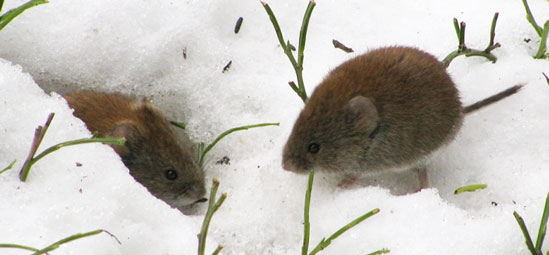Preventing Winter Lawn Damage From Voles
By Chris Williams on January 30, 2015.

In past winters, we’ve had a problem with what we’ve been told are voles tunneling under the snow cover and destroying our lawn. Have you heard about this? Is there anything we can do to prevent the damage? L. B., Candia, NH
It’s true that we usually think of voles as spring or summertime pests in gardens, but fact is that most of the damage that voles do is done during the winter months. Voles are rodents, related to mice (see Mice or Voles in Your Yard?). Unlike many mammals, voles do not hibernate, or even slow down, during the winter. And snow is not a detriment, but is a plus as far as meadow voles are concerned.
Wintertime is Tunneling Time
A vole’s life is tunneling through the surface of grasses (or sometimes old mole tunnels) to reach food that is mostly grass and other plants, and sometimes seeds. When there is snow cover, voles continue to work their tunnels and feed on grasses, operating in the insulated space between the grass and the snow. Besides the winter damage to lawns, voles can also damage trees as they chew off bark from below the snow line. They can girdle and kill small trees.
Vole damage isn’t usually discovered until snow melt in spring. In general, the more snow, the more vole damage you’ll see. Voles leave evidence of their presence with narrow, winding surface tunnels, small burrow openings, piles of dead grass, and gnawed areas on tree trunks.
Take These Steps to Prevent Vole Winter Damage
The way to prevent vole winter damage is to implement vole control measures before winter.
- Keep mowing your lawn in the fall until frost, but don’t mow it shorter than two inches to prevent winter injury to the grass.
- To prevent vole tunneling, remove excess thatch and keep mulch less than two inches deep. Plastic weed barriers on plant beds actually encourage vole tunneling.
- Remove materials that provide winter cover for voles such as heavy mulch, heavy leaf cover, weeds, wild grasses, and litter.
- To prevent vole damage to trees, clear snow from around the trees’ trunks, or install a wire mesh cylinder around the trunk that is buried 3-6 inches in the soil and extends 18 inches above the surface.
- Call Colonial Pest to inspect and evaluate your property for a vole control program. If you let us rid your yard of voles before winter, your lawn and trees can take a deserved winter rest.
Photo credit: Tomi Tapio / Foter / CC BY
Stay up-to-date with Colonial Pest’s email newsletter!